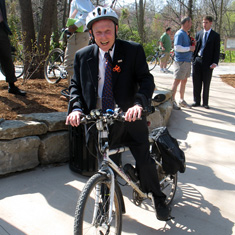Cycle communities
For the next year, I will be working as a bicycle and pedestrian planner for a county located within the Baltimore-Washington region, tasked with producing a b&p master plan for a portion of the "urban area" of the county (with a couple of rural-related tasks as well). This study area is larger than DC, and the mode split -- the number of trips to and from work that are conducted by transit, bicycle, or by walking -- is extremely low.
There are a variety of issues that have to be addressed to convert the community into one that embraces walking, bicycling, and transit much more than it does currently--both in terms of the local government and how it is focused on these issues, as well as on how to build the grassroots momentum and support for expanding how people think about mobility, particularly walking and bicycling.
So the Sunday Parade Magazine article about bicycling, specifically in Columbia, Missouri, is interesting. See "Reinventing America: A Free-Wheeling City."
It happens that I was looking at another initiative in Columbia just last week--THEY HAVE A LAW THAT FINES PEOPLE FOR VERBAL AND PHYSICAL ASSAULT ON BICYCLISTS. (See Bicycle harassment ordinance passes unanimously" and "City Council still divided on bicycle harassment" from the Columbia Missourian.)
Given that the average "vehicular" bicyclist is harassed on a week-in, week-out basis, you can imagine that I think that this is a welcome law and an important step forward.
The Parade article mentions a Federal pilot program that I didn't know about--two cities and two counties have been chosen as places to model--demonstration towns--the development of a bicycling-supportive community. From the article:
The Federal Highway Administration has launched a pilot program with an aim to make roads safer and more enjoyable. More than $90 million has been allocated to four communities—Columbia, Minneapolis, Sheboygan County, Wis., and Marin County, Calif. Each will receive about $22.5 million to make them more bicycle- and pedestrian-friendly.
With the support of Sen. Christopher S. Bond (R., Mo.), who helped launch the program, Hindman recently ordered concrete bike paths alongside Columbia’s streets, rejiggered major intersections for bike safety, and turned existing residential streets into “bike boulevards” with painted bike lanes and obstacles to slow down cars.
See these webpages from the FHWA: Nonmotorized Transportation Pilot Program and the Program Updates and Fact Sheets.
I know I will be delving into this program for insights into my current project. (There is so much to learn and figure out.)
It happens that last year, I wrote about a similar program, Cycle Towns, in the United Kingdom. That entry is reprinted below. I guess I have to take back my words as the US Department of Transportation is doing a "Cycle Towns" type of program.

Darwin Hindman, Mayor of Columbia, Missouri. Parade Magazine photo.
And the Mayor of Columbia, Darwin Hindman, will be an inspiration as well. From the Parade Magazine article:
But Columbia’s most stalwart cyclist is probably the mayor. Hindman rides about 60 miles each week—to the grocery store, to meetings, and to the dog park, hauling his faithful mutt, Loki, in a bike trailer.
Hindman’s next goal is to connect every neighborhood to a bike path, in the hope that he can continue to wean citizens from auto-dependence. “If we could get people to use their bikes or walk on 20% of their short trips, I’d be delighted,” he says.
Not just eco-towns in the UK, but cycle towns too
(I have been thinking quite a bit about transformational delivery of government services. I wrote about it last month, in terms of Arlington County specifically, but there are other examples such as Tower Hamlets' repositioning of libraries into Idea Stores and the Live Baltimore resident attraction program. I was talking about this with a colleague yesterday, and she said it's not just about transforming how the government delivers services, but about transforming people. That point has to be made clearer going forward.)
The Evening Telegraph of Kettering, UK reports, in "We're in chase to be first of cycle towns" that:
Cycling England, which was set up by the Government in 2005, is looking for 10 towns and one city to be transformed into cycling towns after a successful trial in six towns across the country.
Also see Demonstration Towns from the Cycling England website (note that this appears to be a better program than Bicycling Magazine's Biketown, which is very much focused on individuals within communities, rather than communities and the bicycling-walking-urban design environment) and Cycling Towns of the Future conference, 21st November 2007
Imagine the U.S. Department of Transportation doing that, instead of the Secretary of Transportation stating that bicycling isn't transportation. See "The bicycle thief" from Salon.
This is comparable to the Conservative and Labour Party candidates for Mayor of London competing in part on which is more committed to bicycling. (See "Livingstone plan for street-corner cycle hire stands" from the Independent.)
Labels: bicycling, transportation planning, urban design/placemaking



0 Comments:
Post a Comment
<< Home